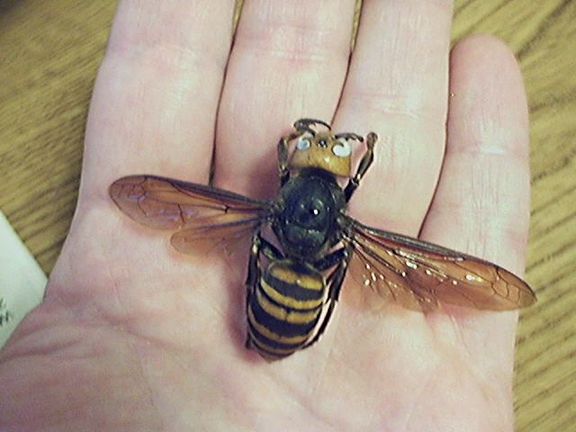
Lynn Kimsey, director of the Bohart Museum of Entomology and professor of entomology at the University of California, Davis, is fielding scores of calls after the National Geographic News (NGN) posted an article today (Oct. 4) about “the world’s biggest hornet wreaking havoc in northwestern China.”
Quoting the Chinese news agency Zinhua, NGN reporter Brian Handwerk wrote that 42 people have died and some 1600 have been injured “since the outbreak of the Asian giant hornet (Vespa mandarinia) began in July…and attacks continue even as local authorities take action, including destroying hundreds of hives and improving medical treatment for victims.”
Handwerk quoted Kimsey as saying "The problem with this particular hornet is that it's big, sort of thumb-sized, and it packs a lot of venom. And its nests get fairly large, including maybe several hundred individuals. They are aggressive, they are predatory, and they have been known to kill and eat an entire colony of honeybees.”
"And its nests get fairly large, including maybe several hundred individuals. They are aggressive, they are predatory, and they have been known to kill and eat an entire colony of honeybees," Kimsey told NGN.
Kimsey, known by her colleagues far and wide as "The Wasp Woman," spent much of the day answering news media queries.
Reached at her Bohart Museum office this afternoon, she said this species is “pretty aggressive.” This species is about two inches long.
“The giant hornet uses its venom to capture prey and to defend the colony,” she said. “But actually, I think the honey bee venom is actually more powerful than this hornet’s venom. The hornet is larger, has more venom, and can sting as many times as it wants." (Only the females sting.)
Unlike a hornet, a worker honey bee dies after stinging.
“This time of year, the hornet colonies are grumpy and agitated,” Kimsey said.
And yes, the Bohart Museum, located in Room 1124 of the Academic Surge Building on Crocker Lane, UC Davis campus, houses giant hornet specimens. After all, it maintains a worldwide collection of nearly 8 million insect specimens.
Read what NGN, CNN and Wikipedia have to say about the world's biggest hornet.
"The stinger of the Asian giant hornet," according to Wikipedia, "is about 6 mm (1/4 of an inch) in length, and injects an especially potent venom that contains, like many bee and wasp venoms, a cytolytic peptide (specifically, a mastoparan) that can damage tissue by stimulating phospholipase action, in addition to its own intrinsic phospholipase. Masato Ono, an entomologist at Tamagawa University near Tokyo, described the sensation as feeling "like a hot nail being driven into my leg."
Attached Images:
